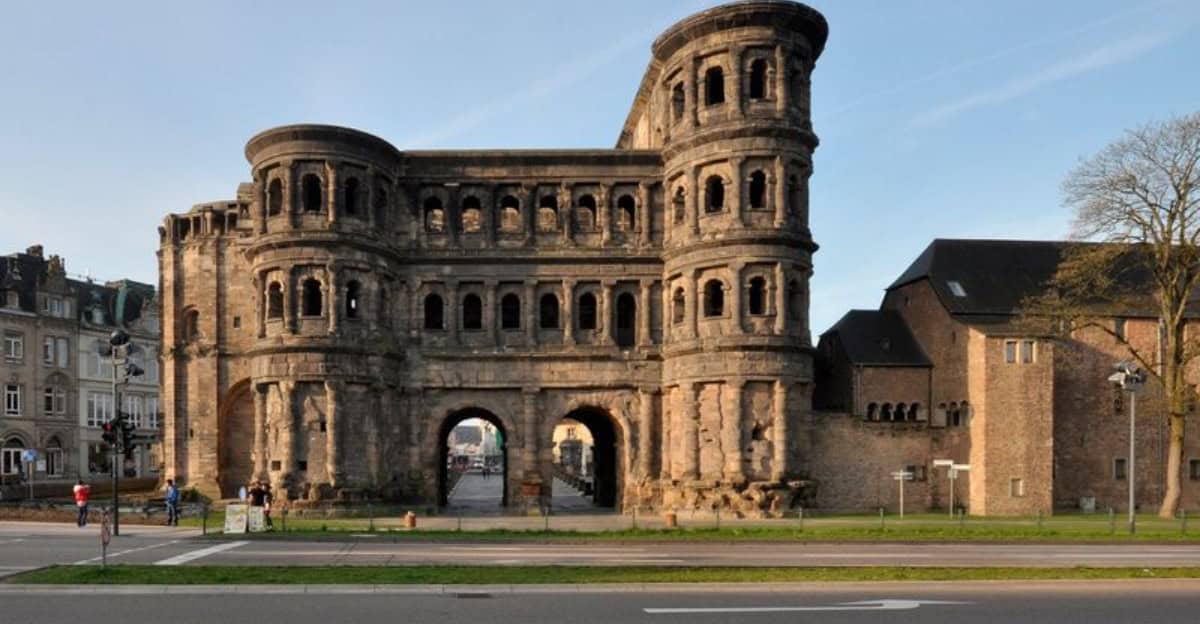Trier, nestled in the heart of Germany, is a city like no other. As Germany’s oldest town, founded in 16 BC, it offers a unique blend of rich history and vibrant culture.
From ancient Roman baths to towering cathedrals, Trier is a treasure trove of historical wonders waiting to be explored.
Whether you’re a history buff or just someone who appreciates timeless beauty, Trier has something for everyone.
Join us as we uncover 10 fascinating facts about this remarkable city that continues to captivate visitors from around the world.
1. Porta Nigra: The Ancient Roman Gate

Standing as a sentinel to the past, Porta Nigra is Trier’s most iconic landmark. This ancient Roman city gate, built around AD 170, captivates visitors with its imposing size and intricate stonework.
As you walk through its archways, you can almost hear the echoes of Roman soldiers marching in times long past.
Today, the gate not only serves as a reminder of Trier’s Roman heritage but also as a vibrant meeting point for locals and tourists alike.
Its blend of antiquity and modernity creates a unique atmosphere you won’t forget.
Don’t miss the guided tours—an enriching journey through time!
2. Trier Cathedral: A Testament to Faith

The Trier Cathedral, or Trierer Dom, stands as a monumental testament to faith and architecture. Built over centuries, its foundations were laid in Roman times, making it the oldest cathedral in Germany.
Inside, the grandeur is palpable, with soaring ceilings and magnificent stained glass windows casting a kaleidoscope of colors.
The cathedral houses the Holy Robe, believed to be the tunic of Christ, adding to its spiritual significance.
Visitors often leave in awe, touched by the blend of history, spirituality, and artistry that defines this sacred space. Truly, it’s a cornerstone of Trier’s identity.
3. Imperial Baths: Ancient Roman Indulgence

The Imperial Baths of Trier showcase the Romans’ affinity for luxury and innovation.
Constructed in the 4th century, these baths were among the largest of the Roman Empire, featuring advanced heating systems that speak to their engineering brilliance.
Exploring the expansive ruins, you can visualize the grandeur that once was—a place where societal elites gathered to unwind. The labyrinth of underground passageways adds mystery and intrigue.
Today, visitors wander among the remnants, connecting with an opulent past where relaxation was an art form. It’s a historical journey not to be missed in Trier.
4. The Aula Palatina: Constantine’s Basilica

The Aula Palatina, also known as the Basilica of Constantine, is an architectural marvel from the early 4th century.
Serving as a throne room for Emperor Constantine, its sheer size and simplicity emphasize the power and authority of the Roman Empire.
Step inside to feel the vastness of the space, with towering walls and an unobstructed view that commands attention. Sunlight floods through the grand windows, creating an awe-inspiring atmosphere.
This basilica, a UNESCO World Heritage site, continues to impress with its historical gravitas and architectural purity. A visit here is a step back in time.
5. Karl Marx House: Birthplace of a Revolutionary

In a quaint house on Brückenstrasse, history was born with the birth of Karl Marx in 1818. This modest home is now a museum dedicated to the life and ideas of the revolutionary thinker.
Visitors can explore exhibits detailing Marx’s influential works and personal history, gaining insight into his role in shaping modern political thought.
The museum offers a reflective journey through the challenges and triumphs of Marx’s life, set against the backdrop of 19th-century Trier.
It’s a thought-provoking experience that invites dialogue and reflection on social change and justice.
6. Rhineland Museum: A Treasure Trove of History

The Rhineland Museum in Trier is a repository of history, showcasing artifacts from the city’s rich past.
Visitors can embark on a journey through time, exploring exhibits that cover everything from Roman antiquities to medieval treasures.
The museum’s highlights include intricate mosaics, statues, and everyday items that paint a vivid picture of life throughout the ages. It’s a place where history speaks, offering a tactile connection to the past.
Whether you’re an avid historian or a curious traveler, the Rhineland Museum promises a captivating exploration of Trier’s cultural heritage.
7. Hauptmarkt: The Heart of Trier

At the center of Trier lies the Hauptmarkt, a lively market square brimming with history and charm.
Surrounded by colorful medieval buildings, this bustling hub is a testament to the city’s vibrant life across centuries.
It’s the perfect spot to soak up local culture, with street vendors, cafes, and shops offering a taste of Trier’s everyday life.
The Hauptmarkt serves as a gathering place for festivals and events, a dynamic space where past and present intersect.
A stroll through the square reveals the city’s soul, inviting you to be part of its living history.
8. Liebfrauenkirche: A Gothic Masterpiece

Adjacent to the Trier Cathedral stands the Liebfrauenkirche, a stunning example of Gothic architecture. This church, dedicated to Our Lady, captivates with its delicate stonework and graceful arches.
Inside, the intricate design continues, with an atmosphere that inspires contemplation and awe.
As one of the earliest Gothic churches in Germany, it embodies a transition in architectural styles that marked a new era.
Visitors often find themselves lost in the beauty of its craftsmanship, a testament to the devotion and artistry of its creators. A visit here is both a visual and spiritual delight.
9. Amphitheater: Echoes of Gladiatorial Combat

The Roman Amphitheater in Trier whispers tales of a bygone era filled with gladiatorial combats and grand spectacles.
Built in the 2nd century, the arena could accommodate up to 20,000 spectators, all there to witness thrilling events.
Walking through the stone seating, you can almost hear the roar of the crowd and feel the anticipation in the air. The amphitheater offers a fascinating glimpse into the entertainment of ancient Rome.
Today, it serves as a venue for cultural events, bridging past and present in a setting steeped in history and drama.

